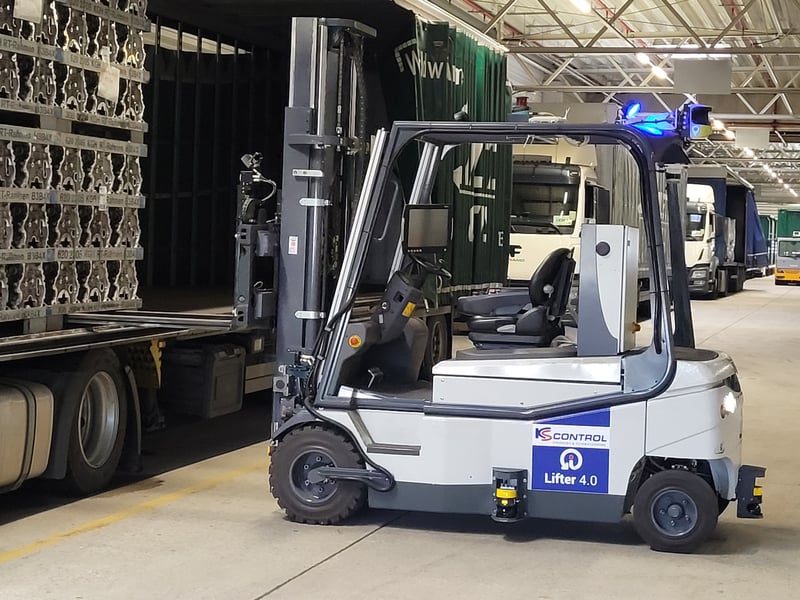What’s in a name? Automated Forklifts vs Forked AGVs
Automated forklifts and forked AGVs have very similar names. But they are very different vehicles.
- An automated forklift is a manual forklift that has been redeveloped by its manufacturer to work autonomously, without a driver. Many automated forklifts are therefore sold as hybrid vehicles: they can work automatically or they can be driven by a human driver if required.
- A forked AGV meanwhile is autonomous by design. It was never designed to be driven manually. Aside from lacking the controls for a human driver to use, forked AGVs work much as any other forklift – they can lift as high and work under similar conditions. Forked AGVs are sometimes also called automated guided forklifts (AGFs), forklift AGVs, or driverless forklifts.
To put it another way, you can think of automated forklifts as a category of lift trucks. While forked AGVs, or AGFs, are a type of automated guided vehicle.

| Forked AGVs (AGFs/forklift AGVs) | Automated forklifts |
|---|---|
| Designed from the ground up for autonomous operation | Automated version of a manual lift truck |
| Slightly higher up-front costs | Slightly lower up-front costs |
| No hybrid operation | Hybrid operation often possible |
| Stops in case of obstacle or can optionally find its own path (obstacle avoidance) | Stops in case of obstacle |
| Less industrialized & shorter product history | Highly industrialized with long product history |

Are forked AGVs more expensive than automated forklifts?
Forked AGVs can have a higher upfront cost than automated forklifts. There are two key reasons for this:
- Manual forklifts have been in industrial use for decades. Most manufacturers are long-established. They have therefore achieved large economies of scale in everything from parts manufacturing, to assembly to distribution. This is not the case (yet) with forked AGVs.
- Forked AGVs usually require more R&D than automated forklifts. This means a higher cost in the short to medium term, although prices are slowly coming down. Data from China, for example, indicates that identical forked AGVs decreased in price by as much as 50% between 2015 and 2021. According to the China Mobile Robot and AGV/AMR Industry Alliance, prices have dropped from just over RMB 600,000 to RMB 270,000 (from around 95,000 USD to 42,500 USD).
However, while forked AGVs may require a larger up-front investment, they may well cost less to maintain. This is because:
- A forked AGV has been designed exactly for purpose, not re-adapted. This can mean smoother maintenance and easier repairs.
- Non-hybrid vehicles literally have fewer moving parts – no steering wheel, for example – so there are fewer things that can go wrong.
- Vehicles that are never driven by humans always work in a controlled, predictable way, which results in less wear and tear on parts.
- For the same reason, forklift AGVs are less likely to cause costly damage to materials and infrastructure than vehicles driven by enthusiastic humans!
Note: Our ROI Calculator can help you calculate when your automated vehicle investment might pay off versus using manual vehicles.
The advantages of automation
Whether you choose a made-for-purpose forked AGV, or a hybrid manual/automated forklift, you’ll reap the benefits of automating your business. These include:
- Automating the most “boring and basic” tasks in your business can improve efficiency, boost productivity, and free up your existing staff to perform more valuable work.
- An improvement in on-site safety. Automated vehicles are significantly safer than their manual counterparts. Manual lift truck accidents cause 10% of injuries in warehousing and factories. By contrast, automatic vehicles are equipped with safety features that make accidents under normal working conditions virtually impossible. And unlike human drivers, they will never exceed the posted speed limits.
- Automation, when implemented correctly, removes the potential for human error, since automated vehicles perform as programmed every time.
All of these benefits ring true, whether you choose an automated forklift or a forked AGV.

